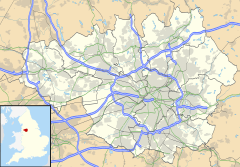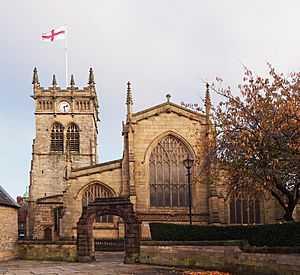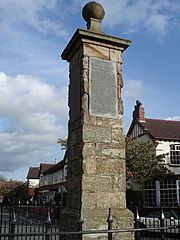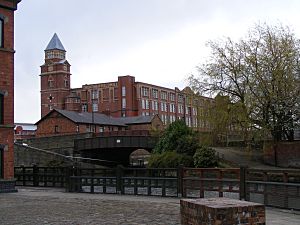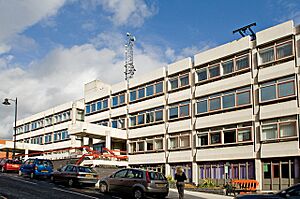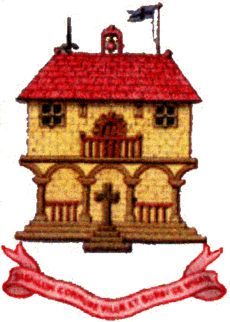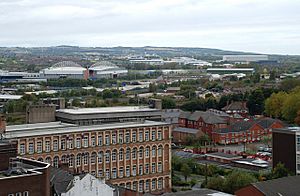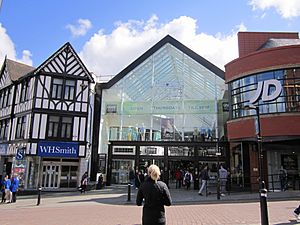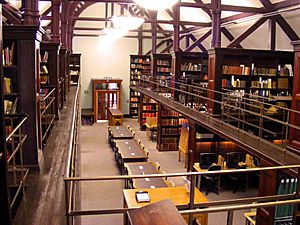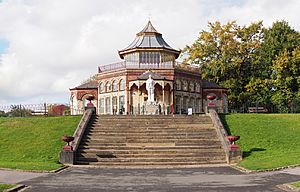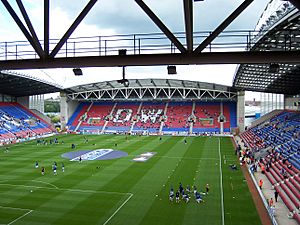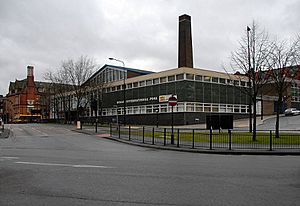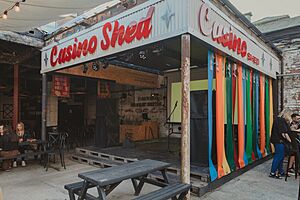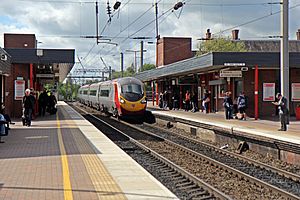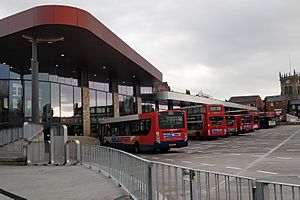Wigan facts for kids
Quick facts for kids Wigan |
|
|---|---|
| Town | |
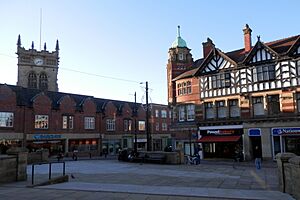 Market Place, Wigan |
|
| Population | 107,732 (2011 Census) |
| OS grid reference | SD583055 |
| • London | 176 miles (283 km) SE |
| Metropolitan borough |
|
| Metropolitan county | |
| Region | |
| Country | England |
| Sovereign state | United Kingdom |
| Post town | WIGAN |
| Postcode district | WN1-WN3, WN5, WN6 |
| Dialling code | 01942 |
| Police | Greater Manchester |
| Fire | Greater Manchester |
| Ambulance | North West |
| EU Parliament | North West England |
| UK Parliament |
|
Wigan is a town in Greater Manchester, England. It sits on the River Douglas. The town is about 16 miles (26 km) south-east of Manchester and 17 miles (27 km) south-west of Liverpool. Wigan is the biggest town in the Metropolitan Borough of Wigan and is its main centre. It has a population of 107,732 people. Wigan is also part of the historic county of Lancashire.
Long ago, Wigan was home to the Brigantes, an ancient Celtic tribe. The Romans later took over, building a settlement called Coccium here. Wigan officially became a borough in 1246. This happened after King Henry III gave it a special paper called a charter.
During the Industrial Revolution, Wigan grew very fast. It became a major mill town and a big coal mining area. At its busiest, there were 1,000 coal mines within 5 miles (8 km) of the town centre. Coal mining stopped in the late 20th century.
Wigan Pier, a dock on the Leeds and Liverpool Canal, became famous. The writer George Orwell wrote about it in his book The Road to Wigan Pier (1937). He showed how tough life was for people in the 1930s. Today, the old warehouses at Wigan Pier are a heritage and cultural spot. The Brick Community Stadium is home to two sports teams: Wigan Athletic Football Club and Wigan Warriors Rugby League Football Club.
Contents
- Discovering Wigan's Past
- How Wigan is Governed
- Wigan's Location and Surroundings
- People and Population in Wigan
- Wigan's Economy and Jobs
- Famous Landmarks in Wigan
- Sports in Wigan
- Education in Wigan
- Wigan's Culture and Entertainment
- Media in Wigan
- Getting Around Wigan
- Famous People from Wigan
- See also
Discovering Wigan's Past
What's in a Name? The History of Wigan
The name Wigan has been written in different ways over time. Some old records show it as Wygayn or Wygan.
The name probably comes from an old Celtic word. It might mean "homestead" or "settlement." Some people think it could also come from a Celtic person's name, like Wigan.
Ancient Times: Brigantes and Romans
Not much is known about Wigan before the Iron Age. But Celtic names nearby, like Bryn and Makerfield, show that Celtic people lived here.
In the 1st century, the Romans arrived and took control. A Roman settlement called Coccium was mentioned in old travel guides. It is believed that Coccium was where Wigan is today. In 2005 and 2008, digs found signs of a large Roman site. They found parts of ditches, possibly from a Roman fort. They also found a big building with stone walls and tiled roofs. This building might have been a bath-house. These discoveries show that Wigan was an important Roman place.
Anglo-Saxons and the Domesday Book
During the Anglo-Saxon period, the area was likely controlled by the Northumbrians and then the Mercians. In the early 900s, people from Scandinavia came to the area. You can see this in names like Scholes, which means "hut" in Scandinavian.
Wigan is not mentioned in the Domesday Book. This might be because it was part of a larger area called Neweton. The church mentioned in Neweton was probably Wigan Parish Church. In 1246, King Henry III gave Wigan a charter. This made it a free borough. Later, in 1257–1258, the town was allowed to hold a market every Monday. It could also have two fairs each year.
Civil War and Local Battles
During the English Civil War, most people in Wigan supported the King. James Stanley, 7th Earl of Derby, a strong Royalist, made Wigan his base. On April 1, 1643, Parliamentarian forces captured Wigan. They took over in just two hours and looted the town. Oliver Cromwell later called Wigan "a great and poor town, and very malignant."
The Battle of Wigan Lane happened on August 25, 1651. It was fought between 1,500 Royalists and 3,000 Parliamentarian soldiers. The Royalists were trying to join the King at Worcester. The Parliamentarians attacked them near Wigan. After two hours, the Royalists were defeated. A monument on Wigan Lane marks where Sir Thomas Tyldesley, a Royalist general, died.
The Industrial Revolution and Growth
In 1698, Wigan was described as a "pretty market town built of stone and brick." In the 1700s, Wigan became a centre for coal, engineering, and textiles. This led to the building of the Douglas Navigation in the 1740s. Later, the Leeds and Liverpool Canal was built. The canal helped transport coal from Wigan's mines to Liverpool and Leeds.
Wigan became a key mill town during the Industrial Revolution. Cotton factories started to appear in the 1800s. By 1818, there were eight cotton mills in the Wallgate area. These mills were known for their tough and unsafe conditions. Workers were paid little, and child labour was common. Wigan was also a major coal producer. In 1854, there were 54 coal mines around the town.
In the 1830s, Wigan was one of the first towns in Britain to get a railway. This connected it to Preston and the Manchester and Liverpool Railway. Wigan became a leading cotton town in the late 1800s. This continued until the mid-1900s.
Irish Connections in Wigan
Wigan saw many Irish people move there in the 1800s. This happened after the Great Famine (Ireland). Between 1851 and 1881, Wigan's population almost doubled. The Irish mainly settled in areas like Scholes and Ince. St Patrick's church in Scholes was built in 1847 because of this large Irish community.
The local rugby league club, Wigan St Patricks, has an Irish shamrock on its badge. Even the Wigan accent has been influenced by Irish immigrants. The word "moidered," meaning confused, is thought to come from an Irish way of saying "mithered."
Wigan in the 20th Century
In 1911, Wigan was described as an "industrial town." It was full of collieries and factories that filled the air with smoke. After the Second World War, Wigan's textile industry struggled and did not recover. The last cotton mill, May Mill, closed in 1980.
In 1937, George Orwell wrote about Wigan in his book The Road to Wigan Pier. He wrote about the poor living conditions of working-class people. Some people like this link to Orwell, as it brings tourists. Others feel it suggests Wigan hasn't improved much since then.
How Wigan is Governed
Since 2004, Wigan town has been split into five areas called wards. Each ward elects three councillors to the borough council. These councillors help run local services.
In 1246, Wigan was given a Royal Charter. This made it a free borough. This meant the town could collect taxes on trade. It also allowed local business people to form a guild to control trade. In 1350, a mayor was elected for the first time. Three people were chosen, and the lord of the manor picked one to be mayor for a year.
There was often a disagreement between the lords of the manor and the borough. The borough tried to take over the lordship in 1583. They felt they were doing the lord's jobs, like improving land and running courts. They reached a deal to share some power.
In 1835, the town was reformed. It was divided into five wards, each with two aldermen and six councillors. The local church rectors were lords of the manor until 1861. Then, the borough bought these rights. In 1889, Wigan became a "county borough." This meant it had its own powers, separate from Lancashire County Council. The Wigan Town Hall was opened in 1991.
Wigan is part of the Wigan Parliamentary constituency. This area sends one Member of Parliament (MP) to the UK Parliament. Since 1918, the Labour Party has represented this area. Lisa Nandy is the current MP for Wigan.
Wigan is also twinned with Angers in France. This means the two towns have a special friendship.
Wigan's Location and Surroundings
Wigan is located at 53.5448°N, 2.6318°W. It is west and north of Hindley and Ashton-in-Makerfield. The town is about 16 miles (26 km) west of Manchester city centre. It is also about 12 miles (19 km) north of Warrington.
The historic town of Wigan is closely linked with Orrell and Ince-in-Makerfield. These areas, along with Skelmersdale in West Lancashire, form the Wigan Urban Area. This area has a total population of 166,840 people. Wigan is also part of the larger Manchester Larger Urban Zone.
People and Population in Wigan
| Wigan Compared | |||
|---|---|---|---|
| 2001 UK census | Wigan | Wigan (borough) | England |
| Total population | 81,203 | 301,415 | 49,138,831 |
| White | 98.8% | 98.7% | 90.9% |
| Asian | 0.4% | 0.4% | 4.6% |
| Black | 0.1% | 0.2% | 2.3% |
In 2001, Wigan had a population of 81,203 people. There were slightly more females than males. About 29% of people over 16 were single, and 45% were married. Many households were one-person homes (30%) or married couples (39%).
In 1931, about 9.4% of Wigan's population was middle class. This grew to 12.4% by 1971. At the same time, the working-class population slowly decreased. This shows that Wigan has kept its image as a working-class town.
In 2001, most Wigan residents (87.7%) said they were Christian. A small number were Muslim, Hindu, or Buddhist. About 6.2% said they had no religion.
| Population growth in Wigan since 1901 | |||||||||||||
|---|---|---|---|---|---|---|---|---|---|---|---|---|---|
| Year | 1901 | 1911 | 1921 | 1931 | 1939 | 1951 | 1961 | 1971 | 1981 | 1991 | 2001 | 2011 | 2019 |
| Population | 82,428 | 89,152 | 89,421 | 85,357 | 81,662 | 84,560 | 78,690 | 81,152 | 88,901 | 85,819 | 98,438 | 103,363 | 107,732 |
| County Borough 1901–1971 • Urban Subdivision 1981–1991 Understanding towns in England and Wales: population and demography 2001-2019 | |||||||||||||
Wigan's Economy and Jobs
| Wigan compared | |||
|---|---|---|---|
| 2001 UK Census | Wigan | Wigan (borough) | England |
| Population of working age | 59,215 | 220,196 | 35,532,091 |
| Full-time employment | 40.7% | 41.7% | 40.8% |
| Part-time employment | 12.7% | 11.9% | 11.8% |
| Self-employed | 5.3% | 6.2% | 8.3% |
| Unemployed | 3.7% | 3.2% | 3.3% |
| Retired | 14.0% | 13.7% | 13.5% |
The Grand Arcade shopping centre opened in 2007. It cost £120 million to build. The area around Wigan Pier is also being redeveloped. This project is called the Wigan Pier Quarter. Trencherfield Mill, a historic building, has been turned into apartments and offices.
The Wigan Life Centre opened in 2011. It has offices for the council, a library, and a swimming pool. There's also a "Believe Square" to honour local people.
Many companies have their headquarters or large facilities in Wigan. The Tote, a betting company, has about 300 jobs here. H. J. Heinz has a huge food factory in Wigan. It is one of the biggest in Europe. JJB Sports and DW Sports Fitness, sports retailers, were also founded here. Local food companies like Galloways Bakers and William Santus & Co. Ltd (makers of Uncle Joe's Mint Balls) are based in Wigan.
In 2001, many people in Wigan worked in retail and manufacturing. There were also jobs in health, construction, and transport. Wigan had more jobs in retail and manufacturing than the average for England.
Famous Landmarks in Wigan
Wigan has 125 listed buildings. These are buildings that are protected because of their history or special design. Mab's Cross is a medieval stone cross from the 1200s. There's a legend about Lady Mabel Bradshaigh walking barefoot to the cross. However, there's no proof the story is true. Haigh Hall was built between 1827 and 1840. It is surrounded by a 250-acre (100 ha) country park.
Mesnes Park opened in 1878. It has a pavilion and a lake. The park is being restored with money from the Heritage Lottery Fund. It gets two million visitors each year.
Wigan's war memorial was built in 1925. It remembers soldiers from the town who died in the First World War and other conflicts. It is a Grade II* listed building. There is also a memorial on Wigan Lane where Sir Thomas Tyldesley died in 1651.
The old Wigan Central Library opened in 1878. It is now the Museum of Wigan Life. George Orwell used this library when he was writing The Road to Wigan Pier. The Wigan Pier Quarter is being redeveloped. Trencherfield Mill, a Grade II listed building, is part of this area. It has a steam engine that is over 100 years old. The Face of Wigan is a large stainless steel sculpture in the town centre. It is 18 feet (5.5 m) tall.
Sports in Wigan
The DW Stadium is a large sports ground in Wigan. It can hold over 25,000 people. It is home to two professional sports teams: Wigan Athletic (football) and Wigan Warriors (rugby league). Both teams moved to the stadium in 1999.
Rugby League Football
Rugby football has been played in Wigan since 1862. Wigan Warriors started in 1872. They are the most successful English rugby league club. They have won many league championships and challenge cups. They have also been crowned world club champions five times. The club plays in the Super League.
Amateur rugby league is also very popular in Wigan. Teams like Wigan St Patricks and Wigan St Judes play in the top amateur league.
Association Football
Football struggled to start in Wigan at first. But in 1920, Wigan Borough became the town's first team in the Football League. They later folded in 1931. A year later, Wigan Athletic was formed.
Wigan Athletic joined the Football League in 1978. In 2005, they were promoted to the Premier League, the top football division in England. In 2013, they won the FA Cup, beating Manchester City 1–0 in the final. They were also relegated to the Championship that same year. As of the 2023–24 season, they play in League One.
Other Sports
Wigan was once famous for wrestling. It was home to the Snake Pit, a famous catch wrestling gym. The gym has since moved nearby.
Wigan also has an American Football club called Wigan Warhawks. They play in the BAFA flag league. The town's swimming club, Wigan BEST, has produced Olympic swimmers. Wigan Wheelers is a cycling club that started in 1919.
Wigan has also hosted motorcycle speedway and greyhound racing. Wigan Warlords is an Inline Hockey team. There is also a district badminton league and a sailing club. The Wigan & District Motor Club runs rallies at Three Sisters Race Circuit.
Education in Wigan
Wigan and Leigh College is a large college with over 8,000 students. It has three campuses in Wigan. These include the Parsons Walk Centre and the Engineering & Construction Centre of Excellence. There is also Wigan UTC, a university technical college, in the town centre.
In the wider area, there are two sixth form colleges: St John Rigby College and Winstanley College. High schools in Wigan include the Deanery High School, St. John Fisher Catholic High School, St. Peter's Catholic High School, and Rose Bridge Academy.
Wigan's Culture and Entertainment
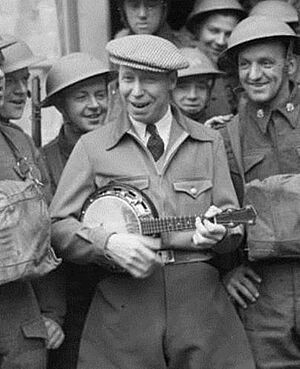
Wigan has a rich history in popular music. Famous musicians like George Formby Sr and George Formby Jr came from here. The town was also home to the Eight Lancashire Lads, a dance group. They gave Charlie Chaplin his first professional performance. Bands like the Verve and Starsailor also started in Wigan. In 2021, the Lathums from Wigan had a UK number one album.
From 1973 to 1981, Wigan Casino was famous for its weekly Northern Soul all-nighters. In 1978, an American music magazine called it the "best disco in the world." The building was later destroyed by fire.
Since 1986, Wigan has hosted an international jazz festival. The town also has many pubs and clubs for young people. A fun tradition since the 1980s is Boxing Day fancy dress. People dress up in costumes, and it often gets national attention.
From 2002 to 2011, the Haigh Music Festival was held at Haigh Hall. It attracted about 7,000 guests each year. Since 2012, the free Wigan Live Festival has taken its place in the town centre.
Wigan also has venues like Feast at The Mills and The Old Courts that host local bands. The Wigan Diggers Festival takes place every September. It celebrates Gerrard Winstanley, who founded the Diggers movement.
Wigan is home to the annual World Pie Eating Championship. This competition has been held since 1992. People from Wigan are sometimes called "pie-eaters." This name might come from the 1926 General Strike. Wigan coal miners had to go back to work before others, so they "ate humble pie." A local dish is the Pie Barm, also known as a Wigan Kebab. It's a buttered bread roll with a meat and potato pie inside. Wigan is also the home of Uncle Joe's Mint Balls.
In the cartoon series Wallace and Gromit, the characters live at a fictional address in Wigan.
Media in Wigan
Local news and TV shows for Wigan are provided by BBC North West and ITV Granada. Radio stations include BBC Radio Merseyside and BBC Radio Lancashire. Other stations are Capital North West & Wales, Heart North West, Smooth North West, and Greatest Hits Radio Wigan & St Helens.
The local newspaper is the Wigan Evening Post.
Getting Around Wigan
Roads
Wigan is located where two main roads, the A49 and A577, meet. These roads connect to the M6, M61, and M58 motorway motorways. Because of more shops and businesses, the main roads can get very busy.
Trains
Wigan has two train stations in the town centre: Wigan North Western and Wigan Wallgate. North Western is on the main north-south West Coast Main Line. You can catch express trains to London Euston, Birmingham, and Glasgow. Local trains also go to Preston and Liverpool Lime Street.
Wigan Wallgate serves lines that run east and west. Trains go to Southport and Manchester. Many trains from Wigan continue to places like Manchester Airport. Pemberton station also serves the Pemberton area of town.
Buses and Canals
In 1880, a horse tramway was built in Wigan. Later, electric trams were used. The tram network closed in 1931 and was replaced by buses. Wigan's buses used to be painted crimson and off-white. They never had outside advertisements.
Today, local buses are run by Transport for Greater Manchester (TfGM). They leave from the Wigan bus station, which was redeveloped in 2018. Long-distance coaches are also available.
Wigan is on the Leeds and Liverpool Canal, famous for Wigan Pier. There is also a branch of the canal that connects Wigan to Leigh. This links Wigan to Manchester via the Bridgewater Canal.
Famous People from Wigan
Many notable people have come from Wigan. You can find a list of them in the List of people from Wigan article.
See also
 In Spanish: Wigan para niños
In Spanish: Wigan para niños


